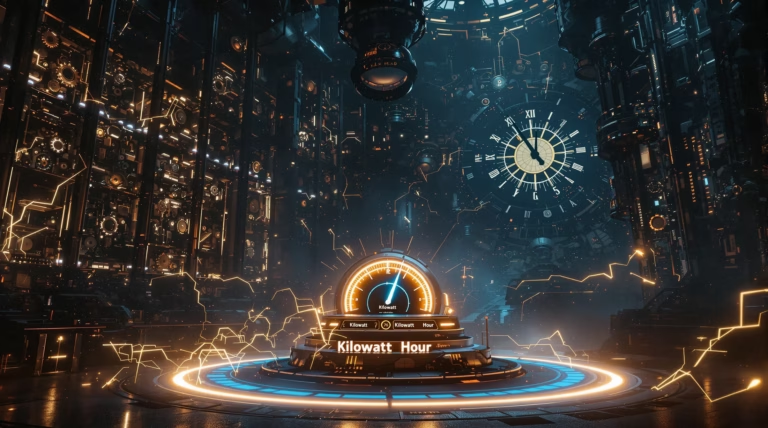Kilowatt vs Kilowatt Hour: Understanding the Key Differences
Understanding the difference between kilowatts (kW) and kilowatt-hours (kWh) is essential for managing your electricity consumption and costs effectively. Let’s explore these fundamental units of electrical measurement and how they impact your daily life.
What is a Kilowatt?
A kilowatt (kW) is a unit of power that measures the rate at which energy is generated or consumed at a specific moment. One kilowatt equals 1,000 watts, with a watt being the standard unit of power in the International System of Units (SI). Think of kilowatts as the speedometer of electricity – they show how much power a device uses or generates at any given time.
Definition and Explanation of Kilowatt
Power represents the instantaneous usage rate of energy, not the total amount consumed. Using the water analogy: if electricity were water flowing through a pipe, the kilowatt would represent the flow rate (gallons per minute). Electrical devices are rated in kilowatts to indicate their capacity – a 5 kW solar panel system can generate electricity at a maximum rate of 5 kilowatts under ideal conditions.
How Kilowatts are Used in Everyday Life
In daily life, kilowatts help us understand and compare power requirements of various devices. Common household appliances typically use the following power:
- Hair dryer – 1.8 kW
- Refrigerator – 0.1-0.2 kW
- Microwave oven – 1.5 kW
- Electric heater – 2.0 kW
- Standard light bulb – 0.06 kW
What is a Kilowatt Hour?
A kilowatt-hour (kWh) measures the total amount of electricity consumed or generated over time. One kilowatt-hour represents the energy consumed when a device with a power rating of one kilowatt operates continuously for one hour. While kilowatts measure instantaneous power rates, kilowatt-hours quantify cumulative energy usage – similar to how an odometer tracks total distance traveled.
Definition and Explanation of Kilowatt Hour
Mathematically, a kilowatt-hour equals 3.6 million joules. Here’s how different devices consume one kilowatt-hour:
| Device Power | Time to Use 1 kWh |
|---|---|
| 100W (0.1 kW) | 10 hours |
| 1000W (1 kW) | 1 hour |
| 2000W (2 kW) | 30 minutes |
Role of Kilowatt Hours in Electricity Billing
Electricity providers use kilowatt-hours as the primary billing unit. For example, if your electricity rate is $0.15 per kWh and your household consumes 500 kWh in a month, your energy charge would be $75. Smart meters now provide real-time or hourly kWh consumption data, enabling consumers to make more informed decisions about their electricity usage.
Kilowatt vs Kilowatt Hour: Key Differences
The fundamental distinction between kilowatt (kW) and kilowatt-hour (kWh) lies in what they measure. Kilowatts indicate power – the rate of energy use at a moment, while kilowatt-hours measure total energy consumed over time. This relationship is crucial for understanding electricity consumption and costs, helping consumers make informed decisions about their energy usage and interpret utility bills correctly.
Kilowatt vs Kilowatt Hour: Key Differences
Understanding Power vs Energy
Power (measured in kilowatts) represents capacity – how much electricity can be generated or consumed at any given instant. It’s comparable to water flow rate through a pipe or vehicle speed. Energy (measured in kilowatt-hours) represents the actual work done or electricity used over time, similar to total water volume delivered or distance traveled.
| Device | Power Rating | Usage Time | Energy Consumed |
|---|---|---|---|
| Electric Shower | 5 kW | 12 minutes | 1 kWh |
| Space Heater | 2 kW | 30 minutes | 1 kWh |
| Light Bulb | 0.1 kW | 10 hours | 1 kWh |
Practical Examples of Kilowatt and Kilowatt Hour
- Air Conditioner (2 kW) running for 5 hours = 10 kWh
- Hair Dryer (1.2 kW) used for 10 minutes = 0.2 kWh
- Light Bulb (0.06 kW) on for 24 hours = 1.44 kWh
- Electric Oven (3 kW) used intermittently
- Refrigerator (0.5 kW) running continuously
High-power devices don’t necessarily lead to high energy consumption if used briefly, while lower-power devices can consume significant energy during extended operation. For effective energy management, consider both the power rating and typical usage duration of appliances.
Why Understanding Kilowatt and Kilowatt Hour Matters
The distinction between kilowatts (kW) and kilowatt-hours (kWh) has practical implications for daily life and financial planning. Kilowatts measure instantaneous power consumption, while kilowatt-hours track total energy use over time. This knowledge helps determine electrical system capacity requirements and understand utility bills.
Impact on Energy Efficiency and Cost Savings
Understanding power requirements helps prevent simultaneous operation of multiple high-consumption devices, avoiding peak demand charges. By tracking kilowatt-hour consumption, households can set specific energy-saving targets and measure progress. Smart meters and online portals now provide detailed consumption data, enabling targeted adjustments to usage patterns for maximum efficiency.
Making Informed Decisions on Electricity Usage
This knowledge supports strategic decision-making about electricity usage, from proper load balancing to evaluating major purchases. When considering appliances, HVAC systems, or renewable energy installations, understanding both power ratings and expected energy consumption enables accurate assessment of:
- Lifetime operating costs
- Return on investment for solar panels
- Electric vehicle charging requirements
- Battery storage system capabilities
- Time-of-use electricity plan benefits







